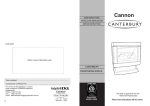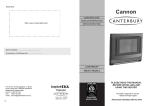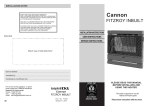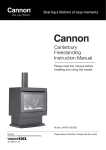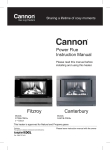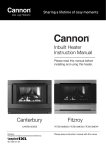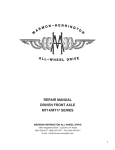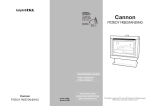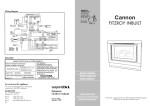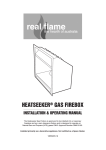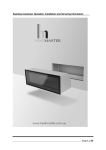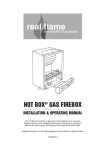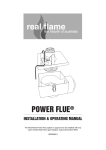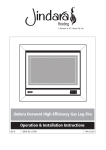Download Cannon Fitzroy Specifications
Transcript
INSTALLATION NOTES Cannon DON’T RISK YOUR APPLIANCE WARRANTY ONLY A LICENSED PERSON WILL GIVE YOU A COMPIANCE CERTIFICATE, SHOWING THAT THE WORK COMPLIES WITH ALL THE RELEVANT STANDARDS. FITZROY INBUILT AND ONLY A LICENSED PERSON WILL HAVE INSURANCE PROTECTING THEIR WORKMANSHIP FOR 6 YEARS. SO MAKE SURE YOU USE A LICENSED PERSON TO INSTALL THIS APPLIANCE AND ASK FOR YOUR COMPLIANCE CERTIFICATE TO ENSURE THE MANUFACTURERS APPLIANCE WARRANTY WILL BE HONOURED. OPERATION INSTRUCTIONS Power Flue INSTALLATION INSTRUCTIONS SERVICE INSTRUCTIONS COPY RATING LABEL HERE Date installed: ............................................................................................... Installed by: ................................................................................................... Compliance Certificate No ............................................................................. PLEASE READ THIS MANUAL BEFORE INSTALLING THIS HEATER. For service to this appliance or spare parts contact the CANNON distributor: Sampford IXL (spare parts) Phone: 1300 727 421 Fax: 1300 727 425 email: [email protected] 28 Cannon FITZROY INBUILT Power Flue Part No: F3045 Revision P - 2010 Gmk10030 AS4553:2008 This heater is approved for use with Natural and Propane gases. Please leave instructions with the owner CONTENTS NOTES Contents 2 Warranty ? Distributor Heater specifications 3 Safety warnings ? What to do if you smell gas ? Warnings ? Standards ? Regulatory location User instructions ? Operating instructions ? Cleaning ? Flame characteristics Installation instructions ? ? ? ? ? ? ? 4 5-6 7 8-9 10 -13 Clearances Fitment of cabinet depth spacer Flueing options Fitment of flue cowl Preparing flexible flue pipes Front fascia removal Sealing the fascia Electrical Connection Gas connections Log installation Gas control 16 16 17 18-19 ? Gas pressure point ? Gas pressure adjustment ? Trouble-shooting 20-21 Service instructions 22-24 ? ? ? ? ? ? ? ? ? ? ? ? ? 2 General To replace the primary glass To replace outer glass To replace the gas control To replace the ignition (module) device To replace the room circulation fan To replace the fan pressure switch To replace the burner and spark/sense electrode To replace the combustion fan Wiring diagram Data plate Date installed, Compliance Certificate No. For service to this appliance 27 NOTES WARRANTY The benefit conferred by this warranty are in addition to all other rights and remedies in respect of the product that consumers have under the Trade Practices Act and similar laws of the States and Territories. We warrant this Cannon appliance to be free of defects in materials, workmanship and manufacturing to the original purchaser for 2 years, (10 years on the heat exchanger) from the date of original purchase. We will, at our option and subject to the terms of this warranty, repair or replace free of charge this Cannon appliance or any component part, which upon examination by us or our repair agent is found to be defective in materials, workmanship or manufacturing. However, this warranty does not cover any consumables (if any). The purchaser must present the original purchase receipt to us when making any claim under this warranty. This warranty will not apply if: (i) a compliance label or serial number (as the case may be) has been removed from the appliance or rendered illegible; (ii) the appliance has been subject to misuse, abuse, accident, incorrect installation or non-domestic use; (iii) the appliance has been modified, tampered with or repaired by a person other than our authorised repair agent; (iv) the appliance is re-installed/relocated during the warranty period. The purchaser is responsible for all travelling expenses if the purchaser requests any repair be carried out at a place outside areas normally serviced by our repair agents. Should you require service on this appliance, please contact our service department on 1300 727 421. Enter the details of the date installed and the Compliance Certificate number in the appropriate area on the rear page of this manual. Don’t risk your appliance warranty Only a licensed person will give you a Compliance Certificate, showing that the work complies with all the relevant standards. And only a licensed person will have insurance protecting their workmanship for 6 years. So make sure you use a licensed person to install this appliance and ask for your Compliance Certificate to ensure the manufacturers appliance warranty will be honoured. Distributor This appliance is designed, manufactured and distributed by: 26 Tel: 1300 727 421 3 YELLOW/GREEN BLUE COILS ROOM FAN - F3594 WHITE BROWN BLUE BLK W BRN BROWN RED BLACK PURPLE GREY FUSE 1.5 AMP BLUE 240 V MAINS PLUG POWER FLUE WIRING DIAGRAM F3663-6_B RED BLUE YELLOW/GREEN E N A PRESSURE SWITCH F3327 ROOM AIR FAN NO NO COMMON IGNITION MODULE F3435 4 WAY SPARK ELECTRODE FLAME SENSOR PRESSURE SWITCH F3327 COMBUSTION FAN MODULATING VALVE F3691 COMBUSTION FAN - F3659 4 WAY COMMON ORANGE FIG 1. BLACK N N BROWN GREY PURPLE ORANGE RED BLUE BLUE A L M FUNCTION CONTROL MODULE P/No. F3604 H TH2 MOD1 MOD2 WHITE BLACK HIGH BRN / HIGH FAN SWITCH ON/OFF MED BRN / MED FAN WHITE 6 WAY CONNECTOR LW BRN / LW FAN 8 WAY CONNECTOR Optional accessories: Glass front Remote thermostat Spacer kit 3 sided surround 4 sided surround Console kit 4 6 WAY CONNECTOR Gas type:Natural or Propane gas, as indicated on data label Gas consumption: 26.0 MJ/hr Energy output: 5.98 kW Enery star rating: 5.05 stars Heater type: Gas space heater approved to AS 4553:2008 Operating pressure: Natural gas: 0.75 kPa (at burner high setting) Propane gas: 2.65kPa Gas regulator: Integral part of controller Min. inlet pressure: 1.13 kPa (NG) 2.75 kPa (Propane) Fan: 3 speed Controller: Electronic direct spark Power requirement: 240 VAC 10 A Power consumption: 90 VA maximum Minimum cavity Height: 605 mm* *(FOR INSTALLATION INTO A dimensions:Width: 700 mm MASONRY/BRICK FIREPLACE) Depth: 485 mm SHEATHED CABLE WIRING DIAGRAM HEATER SPECIFICATIONS 25 SERVICE INSTRUCTIONS notes SAFETY WARNINGS Please read this manual before installing and using the heater. TO REMOVE THE BURNER AND ELECTRODES 1. 2. 3. 4. 5. 6. 7. 8. 9. 10. 11. TO REPLACE THE COMBUSTION FAN Remove the front mesh cover. Slacken off the glass clamp screws and remove the top and one side clamp. Follow fig 25. of the installation instructions for glass removal. Remove the logs from the burner chamber. Remove the inspection hatch cover. Disconnect supply pipe nut from the burner manifold. Remove the electrode connections from the spark module. Release gland seal retaining nut. Remove burner fixing brackets (2) from rh and lh sides of the burner. lift the burner assembly upwards and carefully remove from the burner chamber. Pull electrode leads from the gland seal. Replace in reverse order. The Combustion Fan is accessed from the rear of the heater. Therefore to replace the combustion fan the heater must be removed from the fireplace. The flue terminal may need to be removed from the flue hoses to allow the heater to be moved. 1. Disconnect combustion fan wiring from loom. 2. Remove the rear cover. 3. Remove the four (4) screws securing the fan to fan duct. 4. Remove fan assembly from fan duct. 5. Replace in reverse to disassembly. FIG 31. What to do if you smell gas 1. Turn OFF the main gas supply. 2. Extinguish any open flame. 3. Open windows. 4. Do not touch electrical switches. 5. Do not use your telephone. 6. Call your gas supplier immediately from a neighbour’s phone. Warnings 1. Improper installation, adjustment, alteration, service or maintenance can cause injury or property damage. Refer to the sections of this manual for correct procedures, or consult with place of purchase, a licensed plumber, a gas supplier or the CANNON distributor listed in this manual. 2. Install the heater only in locations that are referred to in the installation instructions. Do not build the heater into bookcases, walls or enclosures without the use of a Mock Fireplace kit if appropriate for that type of installation. 3. Due to high temperatures the room heater should be located out of traffic and away from: Furniture and draperies Combustible materials Gasoline and other flammable liquids Do not place clothing or other flammable material on or near the heater. 4. Keep curtains*, clothes, furniture and other flammable materials at least 900mm from front and sides of heater. * At the owner’s discretion curtain clearance can be less than 900mm as long as they are restrained from the front, top and sides of the heater. The manufacturer takes no responsibility if curtain clearance is less than 900mm and not restrained. 5. Children and adults should be alerted to the hazard of high surface temperature and should take care to avoid burns or clothing ignition. This appliance is not intended for use by persons (including children) with reduced physical, sensory or mental capabilities or lack of experience and knowledge, unless they have been given supervision or instruction concerning use of the appliance by a person responsible for their safety. Children should be supervised to ensure that they do not play with the appliance. 6. Never attempt to burn paper or any other material in the heater. TO REPLACE TYPE “X” CORD 24 1. CONTACT SAMPFORDIXL SERVICE DEPARTMENT AND QUOTE CORD PART NUMBER F2799. 7. Do not place articles on or against this appliance. Do not use or store flammable materials near this appliance. Do not spray aerosols in the vicinity of this appliance while it is in operation. Do not modify this appliance. 5 SAFETY WARNINGS 8. If removed, the glass window must be put back onto the unit prior to operating the heater. 9. Installation and repairs should be performed by a licensed service person only, refer to back of the instructions for service number. 10. For installation into a non-combustible fireplace, i.e.: masonry or brick or into a mock fireplace, i.e. timber or plasterboard, the chimney and base should be of sound construction and be free from cracks and holes (to ensure that sufficient flue draught can be generated). Note: When installing into a mock fireplace a mock fireplace installation kit must be used. 11. The heater must be properly installed in a working chimney or connected to a venting system. Operation of this heater, when not connected into a working chimney or a properly installed and maintained venting system can result in carbon monoxide (CO) poisoning and possible death. 12. Testing the effectiveness of the flue. Before testing the flue confirm air vents are unobstructed. If an exhaust fan or other heating appliances are present switch them on. This is to test that there is no interaction between the Cannon heater and other appliances. Refer to Australian Standard Gas Installations AS 5601. For ‘air movement not to affect appliance’ see clause 5.2.1. For ‘air supply to appliance’ see clause 5.4.1. For ‘ventilation requirements’ see clause 5.4.3. SERVICE INSTRUCTIONS. (DO NOT MODIFY THIS APPLIANCE) To replace the room circulation fan 1 Remove the fascia. Refer page 13, figure 16, of the installation instruction 2. Remove the screw retaining the bracket mounting the valve controls ( white box) Move the bracket and controls to the front of the heater. 3. Disconnect the fan plug from the plug carrier. Remove the two M5 wing nuts which locate the fan to the fan chamber underside. Lower fan from male thread. 4. Disconnect the silicon tubes from the fan pressure switch taking note of spigots the two tubes are connected to. Rotate the fan scroll 90 deg and remove fan from chamber. 5. Replacement fan.Remove the venturi and bracket from the fan removed from the heater. Insert and secure the venturi and bracket on replacement fan. 6. Insert fan into fan chamber ensuring that the silicon tubes are not crushed or kinked. L.ocate fan onto male threads and secure with M5 wing nuts, ensuring rubber buffer locates over thread. 7. Replace silicon tube onto fan pressure switch and reconnect fan wiring. Take care to ensure that silicon tubes are on the correct spigots on the pressure switch. 8. Test operation of room circulation fan and fan pressure switch - turn heater on low heat. The fan should operate immediately. There should be a 5 - 10 second delay before the fan pressure switch is switched dependent upon room temperature. 13. The appliance should be inspected prior to use, with regular inspections (annually) to be made by a licensed service person. It is important that circulating air passageways of the appliance be kept clean, dirt and lint free, for a safe and efficient operation of the heater. Combustion Fan Pressure Switch 14. The first time you use your heater a smell may occur due to its new condition. This is quite normal and will disappear after a few hours use at the maximum control position. Important: When the heater is operating the mesh guard/glass front is hot. The mesh guard, or glass front, fitted to the heater conforms to Australian Standards requirements. The guard is fitted to this appliance to reduce the risk of fire or injury from burns and no part of it should be permanently removed. For protection of young children or the infirm, a second guard is required. Standards This appliance meets the following standards (When installed correctly): Standards Australia: AS/NZS 3100 AS 5601 AS 4553:2008 6 Room Air Fan Pressure Switch FIG 30. To replace the fan pressure switch 1. Remove the fascia. Refer page 14, figure 12, of the installation instruction 2. Remove the screw retaining the bracket mounting the valve controls (white box) Move the bracket and controls to the front of the heater. 3. Remove the connecting wiring (3) from the pressure switch. 4. Remove the silicon tube from the pressure switch. 5. The pressure switch is secured onto the rear of the fan chamberhousing by four M4 screws. Remove screws. 6. Replace in reverse order. 7. Test operation of fan pressure switch - turnheater on low heat. There should be a 5 - 10 second delay before the fan pressure switch to activate dependent upon room temperature. 23 SERVICE INSTRUCTIONS - (DO NOT MODIFY THIS APPLIANCE) REGULATORY LOCATION General 1. Service work to be carried out by an authorised service person only. 2. Unplug from wall socket or turn off power at main switchboard if heater is hard wired. 3. Always shut off the gas supply and ensure that the heater is cool before commencing any service operations. 4. Always check for gas soundness after servicing. FIG 2. MINIMUM CLEARANCES REQUIRED FOR BALANCED FLUE TERMINALS, FAN ASSISTED FLUE TERMINALS, ROOM SEALED APPLIANCE TERMINALS OR THE TERMINALS OF OUTDOOR APPLIANCES. To replace the primary glass 1. Refer pages 13 and 14, steps 7 to 11, of the installation instructions. Refit glass and replace in reverse order ensure the inside surface of the glass is clean and free from finger marks. j F Note: ensure the inside surface of the glass is clean and free from finger marks. k h Door See note 3 d P T I c e e h n a T h j j Openable window g M d k To replace the gas control g 1. Remove the fascia 2. Unplug the cables from the gas control and disconnect the earth connection. 3. Disconnect the gas inlet (1/2” compression nut) connection at entry gas control and the 16mm nut at the outlet of the gas control. 4 . Remove the three M4 screws from the cradle retaining the gas control. 5. Remove gas control. 6 Replace gas control in reverse order and check for gas tightness T = Flue terminal I = Mechanical air inlet Ref a b c d e f g h j Note: check the gas pressure on high and low burner settings. Refer ‘gas control’, pages 13 and 14 k n Ignition module Mounting bracket To replace the ignition (module) device 1. Unplug wire connectors from ignition module. 2. Remove module mounting bracket by removing mounting screw. 3. Using pliers bend tabs so that module can come away from the mounting bracket. 4. Replace ignition device in reverse order. 22 See note 2 M = Gas meter P = Electricity meter or fuse box Item b T Shading indicates prohibited areas for flue terminals Minimum clearances (mm) Fan Natural assisted draft Below eaves, balconies and other projections: Appliances up to 50 MJ/hr input 300 200 Appliances over 50 MJ/hr input 500 300 From the ground, above a balcony or other surface 300 300 From a return wall or external corner 500 500 From a gas meter (M) (see 4.7.11 for vent location of regulator) 1000 1000 From electricity meter or fuse box (P) 500 500 From a drain pipe or soil pipe 150 75 Horizontally from any building structure or obstruction facing a terminal 500 500 From any other flue terminal, cowl, or combustion air intake 500 500 Horizontally from an openable window, door, non-mechanical air inlet or other opening into a building with the exception of sub-floor ventilation: Appliances up t 150 MJ/hr input 500 300 Appliances over 150 MJ/hr input up to 200 MJ/hr input 1500 1500 Appliances over 200 MJ/hr input 1500 1500 All fan assisted flue appliances, in the direction of discharge 1500 From a mechanical air inlet, including a spa blower 1500 1500 Vertically below an openable window, non-mechanical air inlet, or any other opening into a building with the exception of sub-floor ventilation: Space heaters up to 50 MJ/hr input 150 150 Other appliances up to 50 MJ/hr 500 500 Appliances over 50 MJ/hr input and up to 150 MJ/hr input 1000 1000 Appliances over 150 MJ/hr 1500 1500 - unless appliance is certified for closer installation Notes: 1 All distances are measured to the nearest part of the terminal. 2 Prohibited area below electricity meter or fuse box extends to ground level. 3 See clause 5.13.6.6 for restrictions on the flue terminal under covered areas. 4 See Appendix J. Figures J2(a) and J3(a), for clearances required from a flue terminal to an LP Gas Cylinder. A flue terminal is considered to be a source of ignition. 5 For appliances not addressed above acceptance should be obtained from the technical regulator. FIG 29. THE POWER FLUE HEATER IS FAN ASSISTED. SEE COLUMN HIGHLIGHTED Special Note: This chart shall be read in-conjunction with the full Australian standards. AS 5601 7 TROUBLESHOOTING USER INSTRUCTIONS Operating instructions FIG 3. 5 Confirm spark is produced when heater is turned on. 6 If no spark being produced. Plug the power cord into the wall socket and turn on the power to the heater (see figure 3). Refrain from using an extension cord. Alternatively, switch on the isolation switch and circuit breaker at the main switchboard if the heater has fixed wiring. User controls, figure 4 When there is power available to the heater and it is in the OFF or Standby mode, a red LED located inside the ON/OFF button will flash twice and will extinguish for approximately 3 seconds and then repeat this cycle continuously. ? To turn the heater ON press the ON/OFF button ON / OFF be approximately 5 seconds delay before the ignition system commences. On successful ignition the heater will operate on Low Fire and Low Fan for approximately 3 minutes then will switch to selected setting (if already chosen). ? The LED will extinguish approximately 30 LOW seconds following the ignition startup. 8 Spark is being produced but not at the burner. 9 Sparks, ignites on low flame then extinguishes after 10 seconds. Continues to spark while flame present. 10 No gas to burner LOW, MEDIUM or HIGH button once as required. MEDIUM HIGH heat and HIGH speed fan. 11 FIG 4. polarity. Do not use an extension cord. ? Check polarity in the electrical supply lead to appliance. ? Check that the sense electrode is in flame. ? Check that the appliance is earthed correctly. A check between the earth pin on the plug and an unpainted part of the appliance should see a resistance of 0.1 ohms. ? The gas valve should open at the same time as the igniter ? Test the flame for correct ionisation signal. Fuse blowing. ? If the fuse continues to blow check the solenoid coils for a button once. The burner will extinguish but the fan will continue to operate for approximately 3 minutes. ? If the Ignition system fails to ignite or keep the burner alight, press the ON/OFF button once to turn off the heater. Wait at least 20 seconds before attempting to turn the heater on again. Remember that the fan will continue to operate for approximately 3 minutes after the OFF button has been pressed but you can turn the heater ON again without having to wait for the fan to stop operating. ? Check that the wall socket to the appliance has correct Appliance lights but goes into lockout ? To turn the heater OFF press the ON/OFF HIGH Listen for cracking sound. The spark is misdirected. Check the spark ceramic insulator for signs of cracks. sparks. If there is no gas to the burner when this occurs check the solenoid coils for continuity. ? Check that the gas pressure is present at the test point when the spark is being generated. ? Check that there is gas to the inlet of the gas control. ? Select the desired Heating level by pressing the ? LOW is LOW heat and LOW speed fan. HIGH is Check that the spark lead is connected into the module. Check the continuity of the ht cable. Check that there is no short circuit to earth and spark gap is correct. (see fig 35.) A positive check is to use a jumper wire, connect one end of the earth and hold the other end with insulated pliers 4 mm from the spark generator on the module. If there is no spark to Earth then change the module. FIG 28. once. ? The LED will illuminate and stay lit but there will A blue spark can be seen when the heater ignition process starts. Ensure spark is present between electrode and burner. 12 Connect a multimeter in series with the flame rod and set the function to measure micro-amps. The module will go into lockout if the flame current sensitivity is less than 0.5 micro-amps. The approximate signal strength on high flame is about 10 micro-amps and on low 4 micro-amps. The signal strength will fluctuate but should be greater than 1.5 micro-amps at all times. Take precautions because the ionisation probe can have a high negative voltage and can cause a shock. signs of them being shorted. ? Check the fan and wiring for short circuit. 13 Heater will not start, no indicator lamps. ? Check that the electricity supply is correct. If Nuetral / Active are incorrectly connected the control module will not function. ? If there is an interruption to the power supply 8 the heater will fail safely and switch off. When the power supply has been restored adopt the 20 seconds waiting rule before turning the heater ON. 21 TROUBLESHOOTING-(DO NOT MODIFY THIS APPLIANCE) To check the operation of the electronic (module) controller (Techrite) you will require a digital multimeter with the functions to measure ac / dc voltage, Continuity, resistance and micro-amps. It is critical that the appliance is earthed and that the active and neutral are not reversed. Trouble shooting Guide for Ignition Controller ( Techrite) There is a greeen and red LED on the ignition controller. These act as diagnostic aids when ignition does not occur. Green LED: this is on when the board is energised Red LED: this flashes according to the fault code. Fault Codes Long Short Meaning 0 1 2 2 0 1 Normal startup normal operation Maximum ignition attempts 2 2 Flame failure lockout 1 2 Pressure switch off Check spark electrode , spark connection, gas supply Check Flame sense electrode, lead, connection polarity, earthing on burner Check room air and combustion fans run, pressure switches and silicon tubes from kinks 1 3 Pressure switch on Check contact on Pressure Switch for fault, audible sound should be heard when contact made. 3 1 Pressure switch failed Check combustion fan for obstructions, check room air fan for lint build up. Item no check 20 Action Action 1 No ignition when appliance is turned on Check 240 volts power to heater in incoming plug Connector 2 Power present but appliance not operating If there is power to the electronic module, the ignition module may be in lockout. To reset the module turn off the power supply for 15 seconds and then turn the power on again. Check the diagnostic LED to determine fault code. 3 After resetting the module and the appliance is still not operating. Check the external 1.5 amp fast blow fuse in loom. 4 If the fuse is o.k. and there is power to electronic module Check other connections are in place. If the last checks are correct the ignition electrode should spark at the same time as the gas control solenoid valves open. At this point the spark electrode will activate for up to 10 seconds maximum until the flame has been established. CLEANING All cleaning should be carried out when the heater is cold. Normally the heater should only need wiping with a lint-free damp cloth. Any stubborn stains can be removed with a non-abrasive spray on cleaner. If an abrasive cleaner is used the paint finish will be damaged. For heater fitted with the glass front: All cleaning should be carried out when the heater is cold. Clean the outer glass with a mild liquid or spray on glass cleaner. Do not use harsh abrasive cleaners or sharp metal scrapers to clean the heater glass front since they can scratch the surface, which may result in shattering of the glass. Internally the heater should only be cleaned by an authorised service person. Flame characteristics The heater flame should be stable, not lifting from the burner. The logs should glow after approximately 15 minutes operation on HIGH setting. The heater is a fuel effect unit and is designed to operate with luminous flames and may exhibit slight carbon deposit on the logs. If there is any excess carbon build-up on logs, or the burner flame is unstable, contact Sampford IXL in your state (See rear page). Important: The appliance should be inspected before use and at least annually by an authorised service person. More frequent cleaning may be required due to excessive lint build-up from carpeting, bedding materials, pet hair, etc. It is imperative that control compartments, burners and circulating air passage ways of the appliance be kept clean. Do not use this fire if the glass is cracked or with the glass safety screen removed. Do not use fire with broken or missing logs. If your heater requires attention contact your supplier or authorised service person 9 INSTALLATION DETAIL INSTALLATION DETAIL 3. Switch the control buttons to ‘High flame’ position as indicated in figure 26 and using a screwdriver held in position adjust spanner to the pressure 0.75 kPa for Natural gas or 2.65 kPa for LPG. (Turn clockwise to increase pressure and anticlockwise to decrease pressure). 1. This appliance is to be installed by an authorised service person only. 2. This appliance shall be installed in accordance with the manufacturer’s Installation instructions, local gas fitting regulations, municipal building codes, electrical wiring regulations, and AS5601 the Australian Standard for gas installations. Refer also to AS5601 for pipe sizing tables. 3. Remove the heater from the carton and remove the four transit screws. Check that the heater is suitable for the gas available. Refer to the data label located within the fan chamber (Bottom most area with fascia removed). FIG 26. THIS HEATER IS SUPPLIED WITH STAND OFF BRACKETS AND INSULATION BLANKET FOR INSTALLATION INTO COMBUSTIBLE MATERIALS DO NOT REMOVE ANY PARTS WHEN INSTALLING INTO A COMBUSTIBLE ENCLOSURE (Please dispose of packaging appropriately, keep away from children). 4. Switch the control buttons to ‘Low flame’ position as indicated in figure 27. Retain spanner in position and using a screwdriver adjust the central screw control to give a pressure reading of 0.4 kPa for Natural Gas and 1.1 kPa for LPG. (Turn clockwise to increase pressure and anticlockwise to decrease pressure). Clearances For minimum clearances refer figures 5 and 6. Note: Ensure that the combustion air opening under the heater is not obstructed. 4. Ensure the minimum clearances to combustible materials are maintained during installation, including adequate space for the proper operation and servicing of the heater. For clearances to furniture and curtains refer to warning on page 7. CEILING Fireplace opening 1000 MIN CLEARANCE FLUE TERMINAL 695 710 MIN FIG 5. 100** ** Ensure controls are visible Mock kit opening POWER CAN BE HARD WIRED OR TO A NEAR 10 A OUTLET. 5. Switch heater off and remove the manometer tube. Tighten pressure test point by turning the captive screw fully clockwise. 610 MIN 605 75 mm GAS SUPPLY 50 6. Replace plastic cap. Ensure the little lug is positioned towards lower right hand side to clear the controls. GAS SUPPLY 160 mm 7. Refit the fascia, making sure not to damage the power cord or switch cable. 8. Follow user instructions to turn on heater. Operate the heater of HIGH, MEDIUM and LOW settings. The flame should be stable, no lifting from the burner and the logs should glow after approximately 15 minutes of operation at HIGH burner. FIG 7. A minimum clearance of 100mm must be maintained between the rear of the cabinet and the rear wall of the fireplace. 10 FIG 27. 10 mm 300 MIN 436 485 MIN 585 MIN* FLUE DIA 160 mm * clearance required for vertical flueing FIG 6. MANTLE If the flame is unstable: ? Check that the burner is located correctly. ? Check that the glass front is located correctly and is against the sealing rope. ? Check that the gas pressure is correctly adjusted. If the heater still does not operate to specification refer to the troubleshooting chart on pages 20 & 21, or contact Sampford IXL in your state. 19 GAS CONTROL FLUEING OPTIONS 23. Gas control layout is as indicated in figure 23. The heater is supplied with components to suit a horizontal flue coming through a wall at the back of the heater. The Components include a flue cowl which is designed to be fitted to the outside wall with suitable fasteners. Condensate drain tube 2m and Clamp, and flexible tube sealant. Pressures for ‘Burner full on’ and ‘Burner low flame’ are factory set, however if pressures need to be checked or adjusted follow the procedures described below and on the next two pages. Flexible ducting is provided to attach the heater to the flue cowl. The use of this ducting provides for some flexibility in the manner the flue and intake air are connected.The flue and air intake components are fully attached to the heater prior to the heater being fitted into the cavity. FIG 23. On Propane the gas pressure must be set at 2.65 kPa with burner operating on maximum setting. Burner adjustment (Burner ‘Low flame’) Pressure test point with captive screw Pressure adjustment (Burner ‘Full on’) Plastic Cap 1000 MIN On Natural Gas the gas pressure must be set at 0.75 kPa with burner operating pressure on maximum setting. When flueing the through the roof the Extended Flue Kit is required code FLUEWFX. The maximum length of flue pipes that can be used with the Powerflue heater is 6.0m. TO CEILING MASONARY FIREPLACE APPLICATION 300 1000 MIN Important: To achieve the correct visual flame effect: TO CEILING FIG 8. THROUGH WALL APPLICATION TIMBER or BRICK *1* *1* To check control outlet pressure at burner ‘Full on” and ‘Low Flame” positions remove the plastic cap from the regulator adjustment location as indicated in figures 24 . *2* *2* 485 min 485 min FIG 24. CONSULT MOCK FIRE INSTRUCTION BOOKLET REQUIREMENTS FOR THIS APPLICATION CORNER WALL APPLICATION 517 25min Gas pressure point 24. The pressure point is closed with a captive screw. Turn screw 6 revolutions anticlockwise to open the pressure point as indicated on figure 25 (a) and place manometer tube over the test point as per figure 25(b). 517 *1* *2* 3 38 25 min CONSULT MOCK FIRE INSTRUCTION BOOKLET REQUIREMENTS FOR THIS APPLICATION * 2* 585 min FIG 25a. 18 FIG 25b. Vertical flue installation using extended flue kit code FLUEWFX *1* For any horizontal application top hat section can be removed. *2* Condensation drain must have sufficient fall to provide adequate drainage. ensure no water traps occur in drain. 11 INSTALLATION DETAIL INSTALLATION DETAIL CAVITY REQUIREMENTS The heater is to be fitted into position with the flue pipes fully installed onto the heater. Therefore, the cavity must be prepared to accept the heater first. Before cutting any flue opening in the external wall, the finished floor level must be known. This floor level must include any tiling, loose hearth or panels which will support the heater. All clearances shown in fig 1. & fig 2. must be adhered to. Note: The appliance must be secured at the front to a vertical face. Where this is difficult due building inaccuracies, limited non combustible packing may be used to obtain a suitable vertical surface. Power flue appliances are deeper than non power flue heaters so the cavity may need to be pre-prepared prior to any installation or built to suit. PVC VENT TERMINAL INSTALLATION PVC PIPE PVC ADAPTOR FLUE TERMINAL Conical rain hat section may be removed for horizontal installations CLAMP STAINLESS STEEL PIPE PREPARING THE CAVITY FIG 21. The power flue heater is a high efficiency unit extracting heat which in other heaters would escape in the flue gases. Condensate from the flue gases will be produced from this heater . A condensate drain on the rear of the heater must be connected to a hose to drain this condensate out of the house. This hose must be fitted prior to installation of the heater into the cavity. VERTICAL Check the floor of the cavity is smooth, flat and level. Using your template as a guide, mark the flue cutout on the rear wall of the cavity and cut through from either the inside or the outside to produce a neat round hole in the external wall. EXTERNAL WALL TERMINAL COVER PLATE TOP MARK AND CUT HOLE IN REAR WALL OF THE CAVITY FOR FLUE AND CONDENSATION DRAIN. FLOOR TO BE SMOOTH AND FLAT 12 Fitment of flexible pipes to flue terminal. The flexible tubing is now fully extended out of the hole in the wall. Cut the tubing so that 20 mm is extending past the wall opening. Fit the stainless steel tubing to the flexible pipe from the flue outlet, using silicon sealant to seal the join and a hose clamp. Fit the pvc tubing and the air inlet to the other flexible tube, using a hose clamp. Place Terminal cover plate over both air intake and exhaust air pipes. Fit the stainless tube into the centre pipe of the flue terminal. Using the included cable tie fix the air inlet hose to the flue pipe. Fix Terminal cover to outside wall using suitable fixtures. Bend tabs on Terminal cover and secure Terminal to cover using screws provided. FIG 9. TERMINAL COVER PLATE PLACED TO HAVE TERMINAL ON AN INCLINE. FLUE TERMINAL WALL FIXING: USE SUITABLE FASTENERS FOR WALL CONSTRUCTION FIG 22. 17 INSTALLATION DETAIL INSTALLATION DETAIL 695 mm 160 DIA FLUE OPENING Bend gas pipe and electrical entry tags inwards to allow cable and gas pipe to enter easily. FIG 10. Fully extend the flexible flue and air intake and position these pipes through the hole driled through the wall. Route condensate tube through smaller hole in wall. FIG 17. 20 DIA CONDENSE DRAIN HOLE 345 mm SEALING TAPE APPLIED TO EDGE OF UNIT BEFORE POSITIONING. Position sealing tape around perimeter of heater rear edge behind mounting face. See fig 17. 600 mm INSTALLING HEATER 140 FINISHED FLOOR LEVEL 50 mm Align the gas supply pipe with it’s entry point and the flue with the cutout in the rear wall. FIXING SLOTS IN HEATER FRONT CONNECTIONS 100 mm Slowly slide the heater into position until the mounting face comes into contact with the vertical wall. Note: As heater is slid into position, ensure that condensate and flexible flue pipes are fed through their respective holes. It may be advisable when the heater is positioned halfway into cavity to check hoses from outside to ensure that they are not kinked See fig 17. SUITABLE FIXING SCREW Make electrical and gas connection to heater. Ensure gas soundness and that the connections meet the relevant standards. Fold entry tags back in position over gas pipe and cable. See figs 18, 19 and 20 . To make a template, use a sheet of stiff cardboard or (mdf) medium density fibre board cut to represent the rear of the heater. mark a vertical centre line and an appropriate circle 345 mm from the bottom indicating the flue position cut out. see fig 10. Two lengths of flexible aluminum hose is supplied with the heater. These hoses can be stretched to 1m lengths. FIG 11. Air Inlet FIG 18. Flue outlet. FIG 19. Hard wire electrical connection thru cutout in rear panel. Fit grommet over cable at entry. Hard (fixed) wiring connection to be carried out by a qualified electrician. FIG 20. 16 Place a liberal amount of silicon sealant to the inside of the flexible flue pipe which is to be mounted onto the flue outlet. Slip the flexible aluminum hose over the flue outlet with a hose clamp, Tighten the hose clamp to ensure the hose is securely attached to the flue outlet. The flexible aluminum hose is attached to the air inlet in the same manner, however there is no need to apply the silicon sealant on the air inlet. For electrical connection to 10 amp wall socket, run cord thru cutout in fan chamber panel.(either side) Ensure that the cord cannot be trapped when the heater is Installed. GAS CONNECTION GAS SUPPLY Condensate drain Secure condensate tube to drain using supplied clamp. 13 LOG INSTALLATION FRONT FASCIA REMOVAL 1. Remove the wire mesh grille by gently lifting it upwards and then outwards. Similarly remove a fitted glass kit by also gently lifting it upwards and then outwards. Carefully unpack the log set. Logs are numbered as follows: no1 left front no2 left back no3 right front no4 right back log. 2. Remove 4 M5 screws fixing the fascia assembly to the heater body. Bring the bottom of the fascia towards you gently to partly disengage it from the body of the heater. After it has been disengaged gently lift it up vertically to completely disengage it from the body of the heater. Refer figure 12. Position the four individually numbered logs in the following order on the burner as shown in fig.15 The male locating pins in the burner must engage with the corresponding holes in the individual logs. see fig 15. (a) Place log no 1 onto the 2 front pins on the burner head, ensuring that the charring faces the front. (b) Place log no 2 onto the two left back pins. ( c) Place log no 3 onto the single right front pin, ensure the fork locates over log no 2. FIG 12. To fully remove the fascia, unclip the switch cable from the cable connector on the PCB and unclip the cable from the clipping points on the rear of the fascia. 17 (d) Place log no 4 onto the single right back pin, ensurezeft side of log rests in the depression in log no 3. FIG 13. FIG 15. SHOWS POSITONING OF LOGS RELATIVE TO EACH OTHER. 3. To remove the inner glass: see Fig14. Loosen off all the clamp screws. Completely remove the one vertical side and the top clamp.. Try not to touch the front surface of the glass to avoid finger marks. Remove the glass by sliding the glass sideways out of the clamp and then lifting out from the bottom. Place the glass in a safe position for refit later. REFITTING FRONT GLASS Refit the front glass, slide into lower clamp and then under side clamp. Make sure that it is seated evenly on sealing rope. replace top and side clamp and secure. Make sure not to over tighten the clamp screws. Note: An air tight seal is to be achieved between glass and seal. Care should be taken to achieve this. FIG 14. 14 FIG 16. 15














